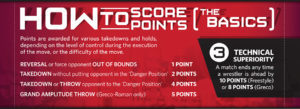History
Wrestling can be traced back to ancient times as well as throughout the ancient and modern Olympic Games. Wrestling was contested at the first ancient Olympic Games in 776 BC and has been on the Olympic programme since the modern Olympic Games resumed in Athens in 1896 (with the exception of 1900), with Greco-Roman wrestling. Freestyle wrestling first made its appearance in 1904.
In September 2001, the International Olympic Committee announced the inclusion of women’s Freestyle wrestling at the 2004 Olympic Games in Athens. In February 2013, the International Olympic Committee made a recommendation to remove the sport from the 2020 & 2024 Olympic programme. However, on September 8th, 2013, the IOC announced that wrestling would be reinstated on the Olympic programme for 2020 and 2024.
Overview
Wrestling has two Olympic styles: Freestyle (men and women) and Greco-Roman. In Freestyle wrestling it is permissible to grasp the legs of the opponent, to trip the opponent and to use the legs as well as the upper body in the execution of any action. In Greco-Roman wrestling it is forbidden to intentionally grasp the opponent below the hips, to trip the opponent or to use the legs actively in executing any action.
Spectator Guide
Equipment
The wrestling area is a square or octagonal mat measuring 12 metres on each side. The “central wrestling area” is a large circle in the middle of the mat, measuring seven metres in diameter, and includes an orange-coloured circle (1 metre in diameter) in the centre of the mat. An orange-coloured “passive zone”, one metre in width, borders the central wrestling area. Wrestlers square off in the centre of the mat at the beginning of a match or whenever the referee restarts the match after wrestling has extended beyond the passive zone (out-of-bounds). The two diametrically opposite corners of the mat have the colours of the wrestling singlets worn by the two opponents: red and blue.
Weight Categories
Wrestlers are divided into categories according to their age and weight. The U20, U23 and Senior weight categories are as follows:
Women’s Wrestling (WW)
50 kg
53 kg
55 kg (non-Olympic)
57 kg
59 kg (non-Olympic)
62 kg
65 kg (non-Olympic)
68 kg
72 kg (non-Olympic)
76 kg
Men’s Freestyle (FS)
57 kg
61 kg (non-Olympic)
65 kg
70 kg (non-Olympic)
74 kg
79 kg (non-Olympic)
86 kg
92 kg (non-Olympic)
97 kg
125 kg
Men’s Greco-Roman (GR)
55 kg (non-Olympic)
60 kg
63 kg (non-Olympic)
67 kg
72 kg (non-Olympic)
77 kg
82 kg (non-Olympic)
87 kg
97 kg
130 kg
Attire
Wrestlers must wear a “singlet” of the colour assigned to them (red or blue). The singlet must be 60% majority red or blue and a maximum of mid-thigh in length. When called to the mat, wrestlers must appear on the edge of the mat, in their respectively coloured corners, with singlet straps up and shoelaces secured.
Officials
Three officials score a wrestling match: the referee, the judge and the mat chairman. The referee is on the mat and makes the initial call on points, which are verified by the judge (mat-side). The mat chairman has the final say on points awarded if there is a disagreement between the referee and the judge.
The Match
The match will consist of two periods, three minutes in length each, with 30 seconds interval between each period. A match may be won by “fall”, by technical superiority or by points.
A fall or pin is called when both shoulders of the defensive wrestler are instantaneously held in contact with the mat for a sufficient time to allow the referee to observe total control. The referee acknowledges and registers the fall (having first agreed with the judge or mat chairman) by blowing the whistle and simultaneously striking the mat with his/her hand. A fall signals the end of the match regardless of the period in which it occurs or the score of the wrestlers at that point.
If there are no falls, the match is judged on cumulative points scored throughout the match. If at any time the difference in points between the wrestlers is more than ten in Freestyle and more than 8 in Greco-Roman, the match is stopped and the winner of the match is the wrestler who holds the lead, due to a “technical superiority” over his/her opponent.
If the match lasts the entire regulation time period, the wrestler with the most technical points is declared the winner. If the score is tied at the end of the match, the winner will be declared by considering the highest value of takedowns and holds, the least amount of cautions and the last technical point(s) scored.
Technical Points (Freestyle)
Technical points are awarded for various takedowns and holds, depending on the level of control during the execution of the move, or the difficulty of the move.
- One point is awarded for stepping out of bounds or reversals, whereby a wrestler in the defensive par terre position executes an action, which now puts him/her behind and in control of the opponent on the mat.
- Two points are awarded for a “takedown” – when a wrestler, from the standing or neutral position, takes the opponent to the mat without back exposure.
- Four points are awarded for a “takedown” or “throw” to the danger position – when a wrestler, from the standing or neutral position, takes the opponent to the mat with direct back exposure to the mat (danger position).
- Cautions – wrestlers who flee the mat, flee a hold, apply an illegal hold, or assume an incorrect par terre starting position, may be given a caution. This results in their opponent receiving one technical point. The opponent of a wrestler who receives three cautions over the duration of a complete match will be declared the winner of the match.
Passivity Procedure (Freestyle)
The fundamental principle of a wrestling match is “total wrestling”. A referee will encourage and stimulate activity at appropriate times throughout the match by gestures and words identifying which wrestler is passive so the wrestler at fault can react. Passivity is considered to be any behaviour on the part of one or both wrestlers who, contrary to the spirit of continuous wrestling, avoid and/or obstruct the progress of the match.
When passivity continues to be evident, the match will be interrupted and a verbal and visual official warning will be awarded. If the wrestler continues to be passive the referee will declare the wrestler “passive” (upon confirmation from the judge or chair). Upon receiving confirmation, the referee will interrupt the match as long as there is no imminent scoring taking place. The referee will indicate to the wrestler (and may indicate to the coach) that the wrestler is “passive”. A 30 second “activity period” will commence and the identified wrestler will have 30 seconds to score or for the opponent to score.
If either wrestler scores during the 30-second activity period the passivity penalty will be suppressed.
If no scoring occurs during the 30-second activity period, the match will be interrupted immediately and the identified wrestler will receive a caution and the opponent will be awarded one point.
Challenge
The challenge is the action through which the coach, on behalf of the wrestler, is allowed to stop the action and request the jury of appeal and the refereeing body to watch video evidence in case of a disagreement with the call.
The coach must request the challenge by throwing a soft object on the mat, immediately after the refereeing body has awarded or failed to award points to the disputed situation.
Each wrestler is entitled to one challenge per match. If after reviewing the challenge, the jury of appeal modifies the decision, then the challenge can be used again during the match. If the jury of appeal confirms the decision by the refereeing body, the wrestler loses the challenge and the opponent will receive one technical point.
The decision of the jury of appeal is considered final and no further appeal is possible on the disputed situation.




